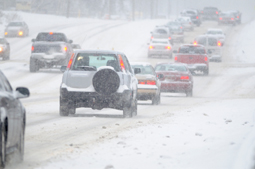Which type of vehicle is best for winter weather?
Posted in Accident & Injury on January 4, 2013
 Last month, Elk & Elk‘s poll question asked what kind of vehicle do you drive: front wheel drive, rear wheel drive, four wheel drive or all wheel drive? Fifty percent of respondents said their vehicles are four wheel drive. Another 25 percent said front wheel and 25 percent said rear wheel.
Last month, Elk & Elk‘s poll question asked what kind of vehicle do you drive: front wheel drive, rear wheel drive, four wheel drive or all wheel drive? Fifty percent of respondents said their vehicles are four wheel drive. Another 25 percent said front wheel and 25 percent said rear wheel.
Each type of vehicle has its upside and its downside. It’s up to you to decide what kind of driving you do most and figure out which kind of vehicle will best meet your driving needs.
Here is a quick look at the different types of drivetrains:
Rear wheel drive
The main advantage rear wheel drive cars offer is better balance and better handling. While a front wheel drive car has most of the weight of the engine and transaxle over the front wheels, a rear wheel drive car spreads the weight of its drivetrain more evenly front-to-rear. This is why most sports cars are rear wheel drive. However, one big negative is that rear wheel drive cars are very weak in poor weather conditions such as rain or snow. A rear wheel drive car is more prone to loss of traction on slick roads. But if you are lucky enough to live somewhere with very mild winters, you probably won’t mind driving a rear wheel drive vehicle.
Front wheel drive
One big advantage of a front wheel drive vehicle is economy. It is cheaper to design and build a front wheel drive car because there are fewer parts and the drivetrain is easier and cheaper to install. Front wheel drive also helps cut down the car’s weight by eliminating the separate transmission and axle assemblies used in a rear wheel drive car. This, in turn helps the car get better gas mileage. This is why front wheel drive is most commonly found in economy-type and lower-cost cars. Also, front wheel drive vehicles handle better than rear wheel drive vehicles in poor weather conditions because the front wheels pull the car instead of the rear wheels pushing it. And, the weight of the engine/transaxle sits on top of the (front) drive wheels, which further helps the car get a grip. The downside is that front wheel drive cars are front-heavy, which isn’t optimal for handling. In addition, the wheels that drive the car also must steer the car, which can be another negative factor when it comes to handling.
Four wheel drive
This system is typically found in pick-up trucks and truck-based SUVs. Most 4WD systems work “part-time” — engine power goes only to the rear wheels until the driver (or, in the case of automatic systems, the onboard computer) engages the front axles. Typically, the power split front-to-rear is not adjustable. When in four wheel drive mode, the front wheels get 50 percent of the engine’s output and the rear wheels get the other 50 percent in a fixed-ratio split. Four wheel drive systems are great for dealing with very heavy snow on unplowed roads and for off-road driving on muddy, uneven terrain. One downside to four wheel drive systems is the extra weight they add to your vehicle, which decreases your gas mileage
All wheel drive
This is a system in which engine power can be sent to all four wheels — or even to individual wheels — as necessary to maintain traction. All wheel drive provides excellent all-year/all-weather grip on snow-covered roads in winter and improves handling on dry (or wet) paved roads in summer. One advantage all wheel drive systems have over four wheel drive systems is they do not require any driver involvement; power is automatically routed to the wheels with the most traction. And they can send as much as 90 percent of the engine’s power to the front (or rear) wheels, as the traction situation dictates. The downside to all wheel drive is that it can add to the purchase cost of a vehicle.
The bottom line is that no matter which type of vehicle you drive, you still have to be cautious when driving in bad weather conditions, whether it be snow-covered roads or rain-dampened roads. In fact, if you drive an all wheel drive or four wheel drive vehicle which handles better in the snow, you may be prone to drive faster than you should, because even though these vehicles handle the road better, they don’t necessarily help you stop or turn any better in slick conditions.
Always drive appropriately for the weather. On snow-covered roads, make slow, cautious changes in direction and brake smoothly to maintain traction. Leave plenty of room between you and other vehicles, keep your eyes on the road and drive defensively. Avoid sudden or abrupt changes or movements. If you have been injured in a car accident, contact our Columbus car accident attorneys today for a free consultation.